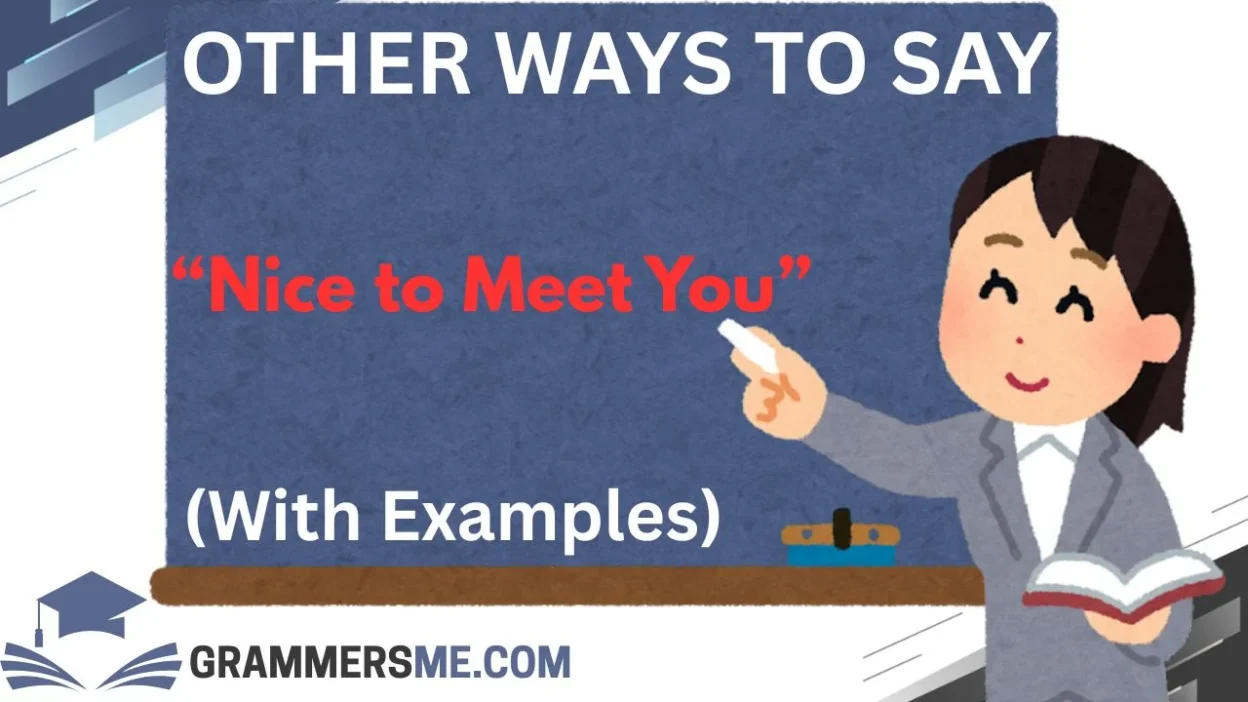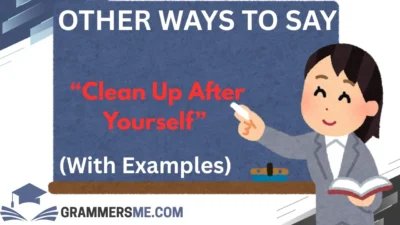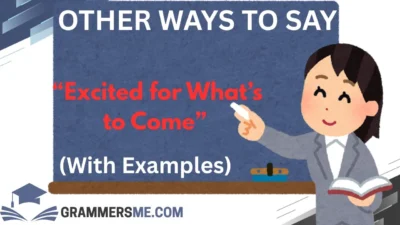When you meet someone new, the first impression often starts with your greeting. The words we choose can set the tone for a positive interaction and leave a lasting impression. While “Nice to meet you” is a classic go-to, there are many other ways to convey warmth, friendliness, and sincerity.
Expressing yourself in a more personal way can make the conversation feel more meaningful and heartfelt. Whether you’re looking for a friendly approach or a more formal one, these 30 alternatives will help you connect with others on a deeper level.
What Does “Nice to Meet You” Mean?
“Nice to meet you” is a common greeting used when meeting someone for the first time. It conveys politeness and is generally used to express that you are happy to make the acquaintance of someone new. It’s a way to acknowledge the moment and show respect and kindness. While it’s widely used in various social and professional settings, sometimes you might want to switch things up to make your greeting feel more genuine.
Is It Professional/Polite to Say “Nice to Meet You”?
Absolutely! Saying “Nice to meet you” is both polite and professional. It’s a friendly yet respectful way to acknowledge someone you’ve just been introduced to. However, depending on the context, you might want to adjust your tone or wording slightly. For example, in more formal settings, phrases like “It’s a pleasure to meet you” might be better received, while in casual scenarios, a simple “Hey, great to meet you!” can work just as well.
Now, let’s dive into 30 creative ways to say “Nice to meet you,” with examples, explanations, and tips for each!
1. It’s a Pleasure to Meet You
Meaning: A slightly more formal version of “Nice to meet you,” conveying a genuine sense of pleasure and respect.
Explanation: This phrase expresses that meeting someone is a delightful experience. It feels more refined and formal, making it ideal for professional settings or when you want to show extra respect.
Scenario Example: When meeting a new client or business partner at a formal meeting, you can say, “It’s a pleasure to meet you, I’m looking forward to working together.”
Best Use: Professional settings, job interviews, or formal introductions.
Not Use: Informal or casual environments
2. I’m So Glad We Finally Met
Meaning: An expression of happiness about meeting someone, often used when there has been some anticipation or a long wait.
Explanation: This phrase shows that you are genuinely happy the meeting is happening, especially if you’ve been hearing about the person for a while or had trouble coordinating the introduction.
Scenario Example: If you’ve heard a lot about someone through mutual friends or coworkers, you might say, “I’m so glad we finally met, I’ve heard so much about you!”
Best Use: Informal or semi-formal situations where you want to show enthusiasm.
Not Use: In highly formal contexts or with someone you’ve just met.
3. It’s Great to Meet You
Meaning: A casual and friendly alternative that expresses pleasure at the introduction.
Explanation: This phrase is light-hearted and shows a positive attitude. It’s less formal than “Nice to meet you,” which makes it a good fit for a more relaxed setting.
Scenario Example: When meeting someone at a social gathering or event, you could say, “Hey, it’s great to meet you! How’s your day been?”
Best Use: Casual or semi-formal social events.
Not Use: Professional or highly formal settings.
4. I’m Excited to Meet You
Meaning: A warm, enthusiastic greeting that conveys genuine eagerness about meeting someone.
Explanation: This phrase expresses excitement, making it a great choice when you want to show you’re looking forward to building a relationship or connection.
Scenario Example: After being introduced to a new colleague or business partner, you might say, “I’m excited to meet you! I’ve heard so much about the work you’ve done.”
Best Use: Informal and semi-formal settings, when meeting someone whose work or reputation excites you.
Not Use: In overly formal or reserved settings.
5. It’s Wonderful to Meet You
Meaning: A polite and slightly more enthusiastic way of saying you’re happy to meet someone.
Explanation: This greeting conveys warmth and genuine appreciation. It’s a good option when you want to elevate your greeting without being too formal.
Scenario Example: At a dinner party, you might introduce yourself with, “It’s wonderful to meet you. I’ve been looking forward to this evening.”
Best Use: Social gatherings or semi-formal events.
Not Use: Professional, first-time business introductions where a more neutral phrase would be better.
6. How Wonderful to Meet You
Meaning: A variation of “It’s wonderful to meet you,” often used when you want to emphasize how delightful the encounter is.
Explanation: Slightly more formal than the previous option, this version carries an added level of appreciation and politeness.
Scenario Example: If you’re meeting someone important or influential, you could say, “How wonderful to meet you. I admire your work and have heard great things.”
Best Use: Formal business settings, professional networks, or when meeting someone you admire.
Not Use: Casual or overly relaxed settings.
7. I’ve Been Looking Forward to Meeting You
Meaning: This phrase shows that you’ve been anticipating the opportunity to meet someone.
Explanation: This expression conveys eagerness and can imply that you’ve heard a lot about the person and were eager to finally meet them in person.
Scenario Example: You could use this when meeting a colleague or industry leader at a conference: “I’ve been looking forward to meeting you – your insights on this field have been really inspiring.”
Best Use: Professional meetings, conferences, or when you’ve been in contact with the person before.
Not Use: When you have no prior connection or if it feels insincere.
8. I’m Delighted to Make Your Acquaintance
Meaning: A formal and polite alternative that conveys genuine delight at meeting someone.
Explanation: This phrase is often used in professional contexts or when you want to make a more polished impression.
Scenario Example: “I’m delighted to make your acquaintance, I’ve heard so much about the incredible work you’ve done.”
Best Use: Professional, formal settings, especially when meeting someone for the first time in a business environment.
Not Use: Informal or casual conversations.
9. It’s So Nice to Meet You
Meaning: A friendly and enthusiastic version of “Nice to meet you,” commonly used in both casual and semi-formal settings.
Explanation: This phrase adds a little more warmth and energy compared to the standard “Nice to meet you.” It’s a great way to make your greeting more personal.
Scenario Example: When meeting someone at a party, “It’s so nice to meet you! What’s your favorite part of this event?”
Best Use: Casual settings or informal professional contexts.
Not Use: In situations where a more formal greeting is expected.
10. How Do You Do?
Meaning: A very formal and old-fashioned way of greeting someone, typically used in highly formal settings.
Explanation: This phrase is less common today, but it still appears in certain formal contexts, especially in more traditional settings.
Scenario Example: In a very formal business or diplomatic meeting, “How do you do?” might be used.
Best Use: Formal occasions, highly traditional environments.
Not Use: Casual or informal settings.
11. It’s an Honor to Meet You
Meaning: A deeply respectful greeting that emphasizes the respect you have for the person you’re meeting.
Explanation: This phrase is often used when you’re meeting someone of higher status or great importance, such as a mentor, celebrity, or leader in your field.
Scenario Example: “It’s an honor to meet you, I’ve admired your work for years.”
Best Use: When meeting someone highly respected or influential.
Not Use: Casual or informal settings.
12. Pleasure to Meet You
Meaning: A polite and professional variation of “Nice to meet you,” suitable for business and formal occasions.
Explanation: This phrase is a slightly more elegant way of expressing pleasure at meeting someone. It carries a sense of respect without being too distant.
Scenario Example: “Pleasure to meet you, I’m looking forward to learning more about your work.”
Best Use: Professional meetings, formal introductions.
Not Use: Casual or friendly environments.
13. I’m Happy to Meet You
Meaning: A warm, friendly greeting that shows happiness and positivity about the meeting.
Explanation: This phrase is slightly more enthusiastic than the classic “Nice to meet you,” making it ideal when you want to be more expressive.
Scenario Example: When meeting someone at a social gathering, “I’m happy to meet you! It’s great to connect with new people.”
Best Use: Informal or semi-formal situations.
Not Use: In overly formal business settings.
14. How’s It Going?
Meaning: A casual and friendly greeting often used when meeting someone in a relaxed or informal setting.
Explanation: This phrase is less about formality and more about making a friendly connection, usually with people you feel comfortable with.
Scenario Example: “How’s it going? I’m [Your Name], nice to meet you!”
Best Use: Informal, casual settings.
Not Use: In professional or formal settings.
15. So Nice to Finally Meet You
Meaning: This shows that the meeting has been long anticipated.
Explanation: It’s often used when you’ve heard a lot about someone before actually meeting them.
Scenario Example: “So nice to finally meet you! I’ve been hearing a lot about your recent project.”
Best Use: Casual or semi-formal, especially if you’ve been talking to the person beforehand.
Not Use: For first-time encounters with no prior connection.
16. It’s a Real Pleasure to Meet You
Meaning: A more heartfelt and sincere version of “Nice to meet you.”
Explanation: This phrase adds a sense of warmth and sincerity to your greeting.
Scenario Example: When meeting someone after a long-awaited introduction, “It’s a real pleasure to meet you, I’ve been looking forward to this moment.”
Best Use: Both professional and semi-formal settings where you want to express genuine pleasure.
Not Use: Casual or informal settings.
17. What a Pleasure to Meet You
Meaning: A polite and enthusiastic version of a formal greeting.
Explanation: This phrase conveys a deep sense of appreciation for the encounter.
Scenario Example: In a business meeting, “What a pleasure to meet you. I’m excited to collaborate on future projects.”
Best Use: Formal or professional introductions.
Not Use: Casual settings.
18. It’s Lovely to Meet You
Meaning: A friendly and warm greeting, often used in both professional and casual contexts.
Explanation: It’s slightly more intimate than “Nice to meet you” but still polite.
Scenario Example: “It’s lovely to meet you, I’ve heard so much about your work.”
Best Use: Professional and semi-formal settings.
Not Use: Overly formal meetings.
19. I’m Thrilled to Meet You
Meaning: A more energetic and enthusiastic way to greet someone.
Explanation: This phrase conveys excitement and eagerness, perfect for situations where you feel truly excited to meet the person.
Scenario Example: “I’m thrilled to meet you, I’ve been following your work for a long time.”
Best Use: Informal or semi-formal, especially when meeting someone influential.
Not Use: Formal business meetings.
20. I’ve Been Eager to Meet You
Meaning: Expressing eagerness about the meeting.
Explanation: This conveys a sense of excitement and anticipation about meeting the person.
Scenario Example: “I’ve been eager to meet you, I’ve heard great things about your work.”
Best Use: Semi-formal settings where you want to express enthusiasm.
Not Use: Highly formal settings.
21. How Do You Do?
Meaning: A very formal greeting, often used in traditional settings.
Explanation: This greeting is often used in situations requiring high respect or formality.
Scenario Example: In highly formal social settings, “How do you do, it’s a pleasure to finally meet you.”
Best Use: Formal occasions.
Not Use: Casual encounters.
22. So Happy to Meet You
Meaning: A casual expression of happiness at meeting someone.
Explanation: This is a straightforward, happy greeting that expresses joy in meeting the person.
Scenario Example: When you meet a friend of a friend at a gathering: “So happy to meet you! How do you know [Friend’s Name]?”
Best Use: Informal settings or gatherings.
Not Use: Professional environments.
23. It’s Great to Finally Meet You
Meaning: A welcoming phrase, expressing happiness after a long-awaited meeting.
Explanation: Similar to “I’ve been looking forward to meeting you,” this phrase emphasizes the joy of the encounter.
Scenario Example: “It’s great to finally meet you! I’ve heard so much about your work.”
Best Use: Semi-formal or informal settings.
Not Use: In overly formal contexts.
24. I’m Grateful to Meet You
Meaning: An expression of gratitude upon meeting someone.
Explanation: This phrase expresses not only happiness but also appreciation for the opportunity to meet someone.
Scenario Example: “I’m grateful to meet you; I’ve learned so much from your work.”
Best Use: Professional or semi-formal environments.
Not Use: Casual, informal settings.
25. It’s an Absolute Pleasure to Meet You
Meaning: A more emphatic way to say “Nice to meet you.”
Explanation: This phrase exudes both excitement and formality, showing a high level of respect.
Scenario Example: “It’s an absolute pleasure to meet you, I’ve heard wonderful things about your achievements.”
Best Use: Formal settings or professional introductions.
Not Use: Casual or informal settings.
26. How Exciting to Meet You
Meaning: Expresses excitement and positivity about meeting the person.
Explanation: This phrase conveys an enthusiastic energy, often used in more dynamic or creative industries.
Scenario Example: “How exciting to meet you! I’ve heard a lot about the innovative projects you’re working on.”
Best Use: Casual or semi-formal contexts, particularly in creative or social industries.
Not Use: Highly formal or traditional settings.
27. Wonderful to Make Your Acquaintance
Meaning: A formal, polite way of saying you’re pleased to meet someone.
Explanation: This phrase is often used in more traditional or polite settings.
Scenario Example: “Wonderful to make your acquaintance, I look forward to our collaboration.”
Best Use: Formal settings, professional environments.
Not Use: Casual conversations.
28. I’m Honored to Meet You
Meaning: A respectful and formal greeting, expressing a high level of esteem for the person.
Explanation: This phrase is used when meeting someone you hold in high regard or someone of significant importance.
Scenario Example: “I’m honored to meet you, your work has had such a profound impact.”
Best Use: Highly formal settings, when meeting an influential or respected figure.
Not Use: Informal or casual introductions.
29. So Excited to Finally Meet You
Meaning: Expresses genuine excitement about the meeting, especially after a long anticipation.
Explanation: This phrase shows a lot of enthusiasm and is perfect for a warm, informal greeting.
Scenario Example: “So excited to finally meet you! I’ve been hearing all about your awesome projects.”
Best Use: Informal or semi-formal settings.
Not Use: Formal or professional settings.
30. It’s Awesome to Meet You
Meaning: A casual and friendly expression showing excitement.
Explanation: This is a very relaxed, enthusiastic phrase used to show excitement in more informal contexts.
Scenario Example: “It’s awesome to meet you! I’ve been wanting to connect for a while.”
Best Use: Informal settings, social gatherings, or friendly encounters.
Not Use: Professional environments or formal business situations.
Conclusion
Finding the right way to say “Nice to meet you” can help set the tone for your interaction and make a lasting impression. Whether you prefer formal or casual, there are plenty of alternatives to choose from that express warmth, care, and enthusiasm. The next time you meet someone new, try using one of these phrases to make your greeting more personal and memorable.
FAQs About Saying “Nice to Meet You”
- Why should I use alternatives to “Nice to meet you”? Using different expressions can make your greetings feel more genuine and tailored to the situation, helping you connect better with others.
- Is it okay to say “Nice to meet you” in a professional setting? Yes, “Nice to meet you” is perfectly professional. However, in formal settings, you may want to consider alternatives that show extra respect.
- How do I know when to use a formal greeting? If the situation is more serious or if the person holds a high rank, it’s best to use a more formal greeting like “It’s a pleasure to meet you.”
- Can I use these alternatives with people I don’t know well? Yes! Many of these alternatives are friendly but polite, and they work well with people you’re meeting for the first time.
- Should I avoid using too much enthusiasm in professional settings? While enthusiasm is great, make sure it fits the context. In a formal business setting, you might want to tone down the excitement to match the tone of the conversation.




